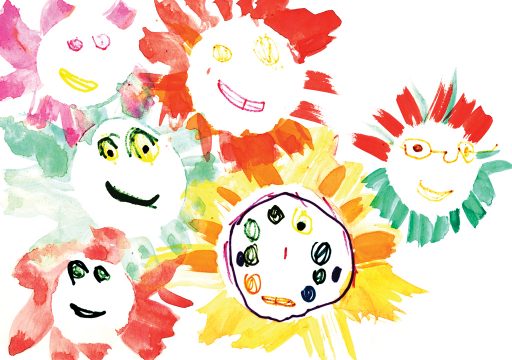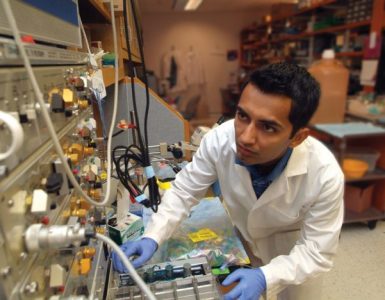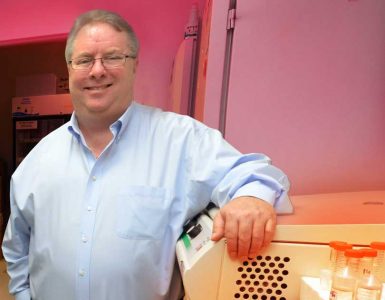
Art educator Dr. Karen Heid and counselor educator Dr. Kathryn Henderson have collaborated with Augusta University’s Department of Patient Engagement to create Art Play Studio, a program that takes art instruction into the Children’s Hospital of Georgia and Augusta University Medical Center. An emerging, multidisciplinary program in the early stages of baseline data collection, it will later expand into partnerships with researchers from all areas of the university, particularly the Georgia Cancer Center.

The two sat down together and discussed the healing power of art.
HENDERSON: Utilizing the senses is how people grow and learn. Part of my background is in trauma and crisis counseling, and that’s a big part of how we teach our clients to understand what they’re experiencing: Even though you might not consciously be thinking about something, that memory is there and a part of your brain in a way that your body still remembers, even if it’s not the first thing on your mind. And there’s an element of that with what we’re doing with these patients. Focusing on their illness or treatment has the power to dominate their experience, so by creating a different type of opportunity, like through art, you’re creating a different type of memory in the brain. It’s a different space for healing to take place that has the potential to really make an impact.
We use a lot of different art in play therapy, and it has very simple but important principles, such as letting the patient always lead, going with their ideas, evaluating their process and not the outcome of their art, and the notion that you don’t have to be an artist to be able to engage in a real, meaningful and fun art experience. So it’s not about the product, but about the process.
HEID: My K-12 training is all the very same thing. We don’t call it play therapy; we say making art. But it all dovetails very nicely, and I think these ideas are starting to pop up all over. Dr. Balas, the dean of the College of Allied Health Sciences, is from a medical school where they actually had art in the medical school, and there are several other schools that have expressive therapies and things like that that patients can engage in.
HENDERSON: We launched Art Play Studio as a therapeutic art and wellness program in the Children’s Hospital of Georgia and on the adult side of the hospital. Right now, Karen and I are administering the program, and we are facilitating the art sessions at the same time. So I am the counselor arm, and she is our artist.
At this point, we are at CHOG on Mondays and the adult side Wednesdays, so one day a week each. But our hope is to expand in the future to include students, either through service learning opportunities for undergraduate and graduate students or with students who might be part of a certificate program that we’re hoping to launch in collaboration with the Medical Illustration program. There are degree programs in arts and medicine at the University of Florida that we’ve been looking at as well as a similar nonprofit group in North Carolina called Arts for Life that’s in four different hospitals.

HEID: We’re both academics, so we’re not
just doing this to make art and all that. We hope to engage in some real data collecting and to put out papers eventually on what we find. There are a couple of doctors at the Cancer Research Center who are interested in doing some big grants and investigating this as we expand.
HENDERSON: Speaking as a counselor, we really believe in the mind-body-spirit connection, so it’s a big part of the biopsychosocial model that is becoming a prominent force in how we treat our patients, or clients as we call them in the counseling field. We can’t just treat the physical self, we also need to consider the mental and spiritual aspects of how an illness or experience impacts the patients. So by looking at and also addressing the other aspects of their experience, we hope that the physical aspect is improved so they all work in tandem.
Art facilitates expression. There is something cathartic about talk therapy. But many people aren’t at the level in processing their illness where they’re ready to talk about it, and art can engage a level of expression that sometimes people aren’t ready to facilitate.
And art is really social. The actual process of engaging in the art sessions is increasing their social activity at a time that can be very isolating. We hope over time to do art group sessions that would have more than one patient at a time, which would also really increase that connectedness, which can be a big part of combating the isolation of being in a hospital room by yourself.
HEID: Right now, we’re basically counting how many people want to make art, how many people actually took art and those kinds of things, but I’d like to get in and research the real nitty-gritty medical aspects of it. The other day, we had a little girl with her hair wound up in a turban and all these wires into her brain. I’d like to study what that is doing when she is just sitting in her room compared to what it’s doing when she’s making art. The world is wide open at this point, and I think getting students in will help that. We can write articles with students, which is a big thing of mine. I love engaging with graduate students and writing articles and setting up studies and things like that.
HENDERSON: Art is a very sensory experience. The feel, the touch, the smell. The other day, Karen had a patient who is blind. We did water colors that day so she was able to feel the wet versus the dry with her hands. So the experience of art is so much more than just the end product. It is really about the whole process. It’s creating some type of self-efficacy through this process of “I can do this,” which increases someone’s ability to be able to sit down and say, “I can still make something. I’m still able to produce. I still have value.” That’s a very counselor thing, but that’s a big part of what the process of creating art is and of art making an impact on an individual’s self-image. Whatever experience they’re going through, they’re still able to create or engage in a different way possibly than before.
HEID: We’re doing a lot of make-and-take art because we’re there with them for that day. But it would be great to have art every single day so they could start something, continue to work on it the next day and the next day, and engage that whole process of sleeping on it and thinking about it in the quiet moments.
That’s something I’d like to do some research on: Are they picking it back up? Have we stimulated them in such a way that really made them want to pick it up later in the day or just before they go to bed or when they first wake up in the morning?
HENDERSON: To me, the thing that’s universal to all the patient experiences is the smiling. With some of the kids, it’s just glee – seeing all the different art supplies and touching the glue dots and having them stick to their fingers. That part of it is really the purpose of why we’re there, and we can learn a lot from that.
Art Play Studio has a GoFundMe campaign at gofundme.com/artplaystudio.










